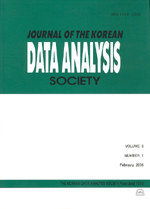메르스 역학 자료를 이용한 감염 Susceptible-Infected-Removed 모형 구축
A Construction of Susceptible-Infected-Removed Model using Korean MERS Pandemic Data
- 한국자료분석학회
- Journal of The Korean Data Analysis Society (JKDAS)
- Vol.18 No.1
-
2016.02105 - 115 (11 pages)
- 71

2015년 여름 우리나라를 강타한 중동 호흡기 증후군(middle east respiratory syndrome; MERS) 전국에 걸쳐 큰 혼란을 일으켰다. 중동 여행을 통해 감염된 최초 감염자에 대한 방역 실패로 인하여 2015년 5월 20일 공식적으로 첫 환자가 확인된 이후 2015년 7월 28일 정부 당국에서 공식적인 확산 종료를 선언할 때까지 총 186명이 확진 판정을 받았고 이 가운데 36명이 사망하였다. 감염자 수는 많지 않으나 치사율이 무려 20%에 육박하였다. 이 기간 총 16,991명이 자가 및 병원에서 격리 상태를 놓였다. 본 연구는 인간의 접촉을 통하여 감염되는 전염성 질환의 수리적인 모형화를 시도하였다. Kermack, McKendrick(1927)에 의한 가장 대표적인 질병 확산 모형인 SIR (susceptible-infected-removed) 모형을 이용하여 모형 구축을 시도하였다. 확산 종료일 기준으로 발생한 결측 자료에 대한 대체 문제를 해결하기 위하여 확률적 가정에서 MCMC(Markov chain Monte Carlo) 방법을 이용하였다. 감염 기간의 계산을 위하여 접촉일 기준과 확진일 기준을 모두 적용하여 구축된 결과에 대한 상호 비교를 진행하였다.
In summer 2015, Korea has a huge problem with MERS (middle east respiratory syndrome) pandemic. According to failure to prevention of the first infectious individual, the first patient was confirmed officially on May 20, 2015. The Korean health authorities officially announced the cease of the pandemic on July 28, 2015. Until that day, totally 186 cases are confirmed with MERS virus, 36 patients died, and 16,991 people are isolated in a hospital or at home by themselves. The number of infection is relatively small, however, the mortality rate is as high as 20%. In this research, we tried to construct statistical modeling for the infectious disease which is infected by human contact. We utilized classical SIR (susceptible-infected-removed) model (Kermack, McKendrick, 1927) for the epidemic model. We utilized MCMC (Markov Chain Monte Carlo) method not only parameter estimation but also imputation of missing information. We considered both contact date and confirmed date to calculate the infectious periods and compared the results between two data sets.
1. 서론
2. 확률적 질병 확산 모형
3. 자료분석
4. 결론
References
(0)
(0)